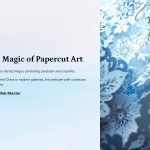

 Papercut art, a centuries-old technique, continues to captivate artists and collectors alike with its intricate designs and delicate craftsmanship. Originating in ancient China, this art form has spread across the globe, evolving into various cultural styles, from the bold Papel Picado of Mexico to the refined Scherenschnitte of Germany. Modern artists push the boundaries of this craft, combining traditional hand-cut methods with laser technology to create stunning masterpieces. Whether used for storytelling, decoration, or fashion, papercut art remains a symbol of patience and artistic brilliance.
Papercut art, a centuries-old technique, continues to captivate artists and collectors alike with its intricate designs and delicate craftsmanship. Originating in ancient China, this art form has spread across the globe, evolving into various cultural styles, from the bold Papel Picado of Mexico to the refined Scherenschnitte of Germany. Modern artists push the boundaries of this craft, combining traditional hand-cut methods with laser technology to create stunning masterpieces. Whether used for storytelling, decoration, or fashion, papercut art remains a symbol of patience and artistic brilliance.

The Rich History of Papercut Art
The origins of papercut art date back to the Han Dynasty in China, around the 4th century AD, shortly after the invention of paper. Initially, artisans used it for religious ceremonies, festive decorations, and even as a medium for conveying folklore. The technique spread across Asia, influencing Japanese Kirigami and Indian Sanjhi art.
As papermaking reached Europe, the craft evolved into distinct styles such as Poland’s Wycinanki and Germany’s Scherenschnitte, each characterized by unique motifs and techniques. In Mexico, Papel Picado became a traditional form used for celebrations, featuring vibrant, perforated designs. Today, papercut art thrives globally, with contemporary artists embracing both hand-cut and laser-cut methods to push creative boundaries.

Essential Tools and Techniques for Papercut Art
Mastering papercut art requires precision, patience, and the right tools. The most essential tools include:
- Precision Knives or Scalpels – Used for detailed cuts and intricate patterns.
- Cutting Mats – Protects surfaces and ensures clean cuts.
- Fine-Tip Scissors – Ideal for curved and delicate shapes.
- High-Quality Paper – From thin rice paper to sturdy cardstock, material selection affects the final piece.
- Tweezers & Glue – Essential for assembling multilayered designs.
Artists use various techniques, from traditional freehand cutting to modern laser-cutting methods. Some prefer the delicate layering of paper, creating a 3D effect, while others focus on negative space to craft breathtaking silhouettes.

Famous Papercut Artists and Their Masterpieces
Several artists have revolutionized papercut art, bringing it into the global spotlight. Some notable names include:
- Béatrice Coron – Known for large-scale narrative papercuts, often depicting cityscapes and intricate storytelling.
- Hina Aoyama – A master of ultra-fine, lace-like designs created with meticulous detail.
- Maude White – Recognized for her expressive figures and intricate use of negative space.
- Patrick Cabral – Blends typography and animal motifs into mesmerizing papercut compositions.
Each artist pushes the boundaries of what can be achieved with just a sheet of paper, proving that this traditional craft still holds endless creative potential.
How to Start Your Own Papercut Art Journey
If you’re inspired to try papercut art, start with simple designs and gradually progress to more complex projects. Here’s a step-by-step guide to get started:
- Choose a Design – Start with a simple silhouette or geometric pattern.
- Select Your Paper – Beginners should use thicker paper to avoid tearing.
- Prepare Your Tools – A sharp craft knife and a steady hand are essential.
- Cut Carefully – Follow the outlines slowly, using light pressure to maintain control.
- Experiment with Layers – Adding depth can make your artwork more dynamic.
- Preserve Your Art – Frame your piece to protect it from damage.
With practice, you’ll develop your unique style, turning ordinary sheets of paper into stunning works of art.

5imz_ Modern Innovations in Papercut Art
Technology has transformed papercut art, expanding its possibilities beyond traditional hand-cut techniques. Today, artists use laser cutting and digital design software to create highly detailed and large-scale works. These innovations have allowed for:
- Intricate Architectural Designs – Used in interior décor and set designs.
- Papercut Fashion – Designers incorporate delicate cutouts into clothing and accessories.
- Interactive Art – Augmented reality (AR) enhances papercut pieces with digital animations.
- Sustainable Art – Eco-conscious artists use recycled paper to create environmentally friendly pieces.
The blend of tradition and technology ensures that papercut art remains a dynamic and evolving medium.
6imz_ The Future of Papercut Art: What’s Next?
As more artists explore papercut art, its applications continue to grow in unexpected ways. Future trends may include:
- 3D Papercut Sculptures – Artists pushing depth and layering techniques to new heights.
- AI-Generated Designs – Using artificial intelligence to assist in complex pattern creation.
- Public Art Installations – Large-scale papercut works integrated into city landscapes.
- Digital Integration – Combining papercut with projection mapping and light installations.
Papercut art, though one of the oldest artistic techniques, remains as innovative and exciting as ever. Whether through traditional hand-cut pieces or futuristic laser-cut wonders, this craft continues to amaze and inspire generations of artists.

